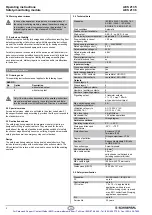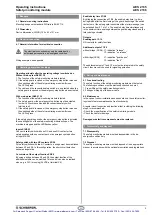
For Sales and Support, Contact Walker EMD • www.walkeremd.com • Toll-free: (800) 876-4444 • Tel: (203) 426-7700 • Fax: (203) 426-7800
3
EN
AES 2135
AES 2136
Operating instructions
Safety-monitoring module
3 Mounting
3.1 General mounting instructions
Mounting: snaps onto standard DIN rails to EN 60715.
3.2 Dimensions
Device dimensions (H/W/D): 100 x 45 x 121 mm
4 Electrical connection
4.1 General information for electrical connection
The electrical connection may only be carried out by
authorised personnel in a de-energised condition.
Wiring examples: see appendix
5 Operating principle and settings
Operating principle after the operating voltage is switched on
Without start-up test AES 2135
1. The function of the safety-monitoring module is tested.
2. If the safety guard is closed or the emergency stop button released,
the enabling paths of the safety-monitoring module will close.
The LED is green.
3. The cable and the connected safety switch are only tested when the
safety guard is opened or the emergency stop button when actuated
With start-up test AES 2136
1. The function of the safety-monitoring module is tested.
2. The safety guard or the emergency stop button must be actuated,
in order to check the cables and the connected safety switch
(start-up test).
3. If the safety guard is closed or the emergency stop button released,
the enabling paths of the safety-monitoring module will close.
The LED is green.
If the safety guard is opened or the emergency-stop button is actuated,
the enabling paths of the safety-monitoring module will open. The
machine is stopped and the LED flashes yellow.
Inputs S14/S22
Connect a safety switch with one NC and one NO contact or two
safety switches with one contact each or an emergency-stop button
at input S14/S22.
Safety switch with two NC contacts X3/X4
For safety switches with two NC contacts, a bridge must be established
between X3 and X4. In this configuration, the short-circuit detection
becomes inoperative.
Conversion of the output function X5/X6
By using a bridge between X5 and X6, the output function of the
additional outputs can be modified. This control can also be realised
when e.g. a PLC is running (24 VDC at terminal X6).
Enable delay time X7/X8
By bridging the connections X7/X8, the enable delay time (i.e. time
during which after the first closing of the guard, bouncing of the switch
contacts or of the entire guard is possible without error message) can
be extended from 0.1 s to 1 s. The enable delay time simultaneously
is the minimum time, expiring between the guard being closed and the
relays being activated.
Outputs
Enabling path 13-14
NO contacts for safety functions
Additional outputs Y1/Y2
without bridge (X5/X6): Y1: indication "release"
Y2: indication "no release"
with bridge (X5/X6): Y1: indication "guard open"
Y2: indication "fault"
The additional outputs Y1 and Y2 must not be integrated in the safety
circuit; they may only be used for signalling purposes.
6 Set-up and maintenance
6.1 Functional testing
The safety function of the safety-monitoring module must be tested.
The following conditions must be previously checked and met:
1. Proper fitting of the safety-monitoring module
2. Fitting and integrity of the power cable
6.2 Maintenance
In the case of correct installation and adequate use, the safety-monitor-
ing module features maintenance-free functionality.
A regular visual inspection and functional test, including the following
steps, is recommended:
• Check the proper fixation of the safety monitoring module
• Check the cable for damage.
Damaged or defective components must be replaced.
7 Disassembly and disposal
7.1 Disassembly
The safety monitoring module must be disassembled in the de-
energised condition only.
7.2 Disposal
The safety monitoring module must be disposed of in an appropriate
manner in accordance with the national prescriptions and legislations.
























